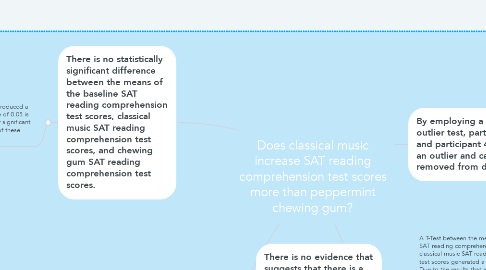Does classical music increase SAT reading comprehension test scores more than peppermint chewing gum?
by Addy Peat

1. There is no statistically significant difference between the means of the baseline SAT reading comprehension test scores, classical music SAT reading comprehension test scores, and chewing gum SAT reading comprehension test scores.
1.1. The single factor ANOVA test produced a p-value of 0.4769205. A p-value of 0.05 is required to conclude a statically significant difference between the means of these three variables.
2. There is no evidence that suggests that there is a statistically significant difference between (1) baseline SAT scores and classical music SAT scores and (2) baseline SAT scores and peppermint chewing gum SAT scores.
2.1. A T-Test between the means of the baseline SAT reading comprehension test scores and classical music SAT reading comprehension test scores generated a p-value of 0.23577. Due to the results that are greater than 0.05, there is no evidence that suggests that there is a difference between baseline scores and music scores.
2.2. A T-Test between the means of the baseline SAT reading comprehension test scores and chewing gum SAT reading comprehension test scores generated a p-value of 0.65794. Due to the results that are greater than 0.05, there is no evidence that suggests that there is a difference between baseline scores and music scores.
3. Conclusion: Classical music and peppermint chewing gum do not increase SAT reading comprehension test scores in Downingtown West High School students.
4. By employing a statistical outlier test, participant 2 and participant 4 exists as an outlier and can be removed from data set.
4.1. The lower fence of raw baseline scores suggests that participant 2 produced an outlying score
4.2. The upper fence of percent change data set of baseline vs. music suggests that participant 2 produced outlying scores
4.3. The lower fence of raw gum scores suggests that participant 2 produced outlying scores.
4.4. After participant 2 was removed and a T-test was re-conducted, there was still no evidence that suggests that there is a statistically signficant difference between percent changes of (1) baseline SAT scores and classical music SAT scores and (2) baseline SAT scores and peppermint chewing gum SAT scores


